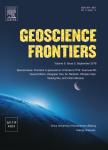Dissolved organic matter tracers reveal contrasting characteristics across high arsenic aquifers in Cambodia:A fluorescence spectroscopy study
Dissolved organic matter tracers reveal contrasting characteristics across high arsenic aquifers in Cambodia:A fluorescence spectroscopy study作者机构:School of Earth and Environmental Sciences and Williamson Research Centre for Molecular Environmental ScienceThe University of ManchesterWilliamson BuildingOxford RoadManchesterM13 9PLUK British Geological SurveyMaclean BuildingWallingfordOxfordshireOX10 8BBUK Lancaster Environment CentreLancaster UniversityLancaster LA1 4YQUK Present address: School of GeographyUniversity of LincolnBrayford PoolLincolnLincolnshireLN6 7 TSUK Present address: Department of Civil and Environmental EngineeringUniversity of StrathclydeGlasgow G1 1XJUK
出 版 物:《Geoscience Frontiers》 (地学前缘(英文版))
年 卷 期:2019年第10卷第5期
页 面:1653-1667页
核心收录:
学科分类:07[理学]
基 金:funded by a NERC Standard Research Grant (NE/J023833/1)to DAP, BvD and Christopher Ballentine(now at University of Oxford) support from the Leverhulme Trust(ECF2015-657) to LAR a NERC PhD studentship(NE/L501591/1)to DM a NERC Collaborative Awards in Science and Engineering PhD studentship (NE/501736/1)to LC
主 题:Arsenic Fluorescence spectroscopy Organic matter characterization Parallel factor analysis (PARAFAC) Groundwater quality
摘 要:Organic matter in the environment is involved in many biogeochemical processes,including the mobilization of geogenic trace elements,such as arsenic,into *** this paper we present the use of fluorescence spectroscopy to characterize the dissolved organic matter (DOM) pool in heavily arsenicaffected groundwaters in Kandal Province,*** fluorescence DOM (fDOM) characteristics between contrasting field areas of differing dominant lithologies were compared and linked to other hydrogeochemical parameters,including arsenic and dissolved methane as well as selected sedimentary ***-corrected fluorescence indices were used to characterize depth profiles and compare field *** fDOM was generally dominated by terrestrial humic and fulvic-like components,with relatively small contributions from microbially-derived,tryptophan-like *** fDOM from sand-dominated sequences typically contained lower tryptophan-like,lower fulvic-like and lower humic-like components,was less bioavailable,and had higher humification index than clay-dominated *** concentrations were strongly correlated with fDOM bioavailability as well as with tryptophan-like components,suggesting that groundwater methane in these arsenic-prone aquifers is likely of biogenic origin.A comparison of fDOM tracers with sedimentary OM tracers is consistent with the hypothesis that external,surface-derived contributions to the aqueous DOM pool are an important control on groundwater hydrogeochemistry.



